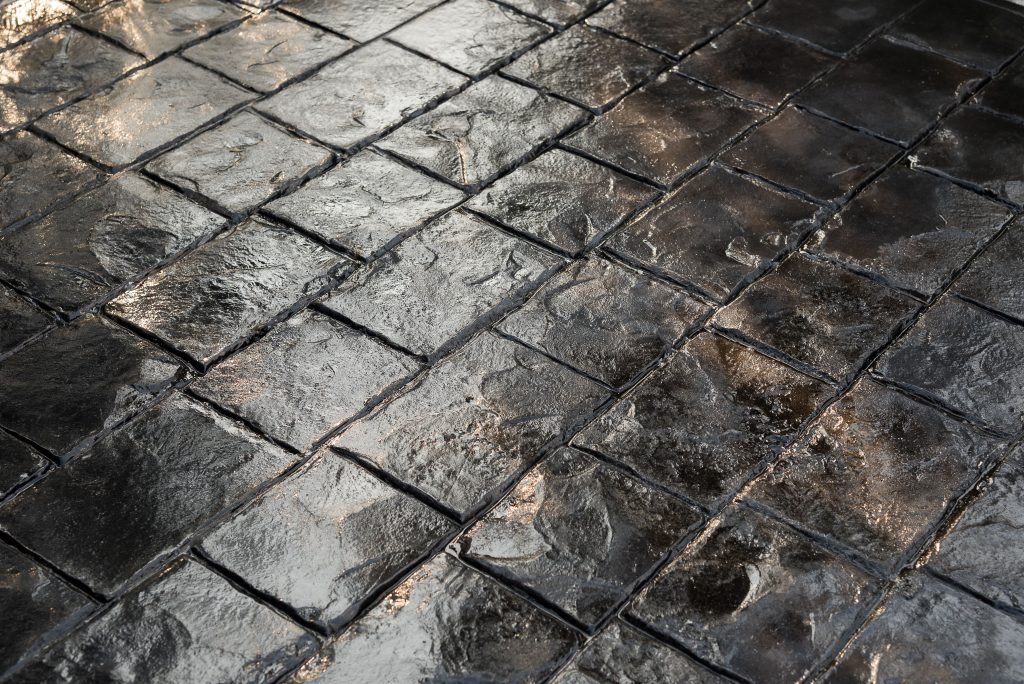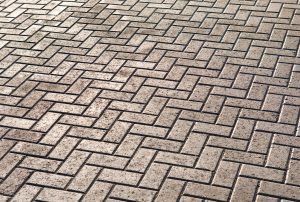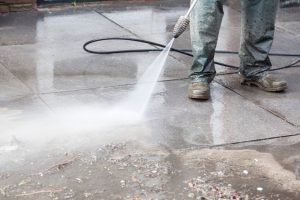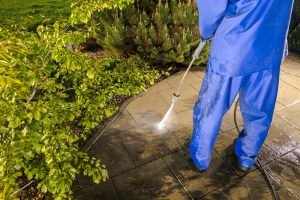Stamped concrete is a popular choice for residential and commercial properties due to its durability, affordability, and versatility in design. However, without proper maintenance and protection, stamped concrete can become susceptible to damage from weather conditions, foot traffic, and other external factors.
Sealing the surface of stamped concrete is an essential preventive measure that offers significant benefits. In this article, we will explore four reasons why sealing stamped concrete is crucial for maintaining its appearance and longevity.
We will discuss how sealing protects against water damage, prevents discoloration and fading, enhances the color and texture of the surface, and minimizes the growth of weeds and moss. By understanding these key advantages of sealers for stamped concrete, property owners can make informed decisions about their maintenance plans to ensure their investment remains attractive and functional for years to come.
The Benefits Of Sealing Your Stamped Concrete
Stamped concrete is a popular choice for outdoor surfaces, such as patios and driveways. It provides an attractive alternative to traditional materials like brick or stone at a lower cost. However, it is important to understand the benefits of sealing stamped concrete in order to ensure its longevity.
One main benefit of sealing stamped concrete is that it protects the surface from damage caused by weathering and UV rays. Water can penetrate unsealed concrete causing cracks and discoloration over time. Sealing the surface with a stamped concrete sealer forms a protective layer preventing water penetration while also reducing fading from prolonged exposure to sunlight.
Additionally, sealing makes cleaning easier as dirt and stains are less likely to adhere to the surface when sealed properly. The benefits of sealing extend beyond protection against environmental factors – it can enhance the color contrast on colored and decorative stamped surfaces making them more vibrant and visually appealing.
Understanding The Importance Of Maintenance
While there are several benefits to having stamped concrete on your property, it is important to understand that maintenance is crucial in maintaining its aesthetic appeal and longevity.
One of the most important aspects of maintenance is sealing the stamped concrete. While some may argue that this step is unnecessary or too time-consuming, resealing your stamped concrete can prevent damage caused by weather exposure, chemical spills, and heavy foot traffic.
In fact, failing to seal a concrete driveway or other exterior surfaces can lead to various problems such as discoloration, cracks, and even structural damage.
Here are four reasons why you must seal stamped concrete:
- Protection from UV rays – Exposure to sunlight causes fading and discoloration.
- Resistance against water penetration – Without proper sealing, moisture can seep into the pores leading to cracking during freezing temperatures.
- Prevention of efflorescence build-up – Efflorescence refers to mineral deposits left behind when ground water evaporates leaving unsightly white stains on your surface.
- Enhancing color vibrancy – Sealing enhances the colors making them more vibrant while adding shine for an impressive finish.
By regularly sealing your stamped concrete every two years or so with a quality sealer like acrylic resin-based products will keep it looking fresh for decades.
The role of sealing in preserving stamped concrete cannot be understated as it ensures long-lasting beauty without much effort involved in repairs due to neglect.
The Role Of Sealing In Preserving Stamped Concrete
Sealing stamped concrete is essential for maintaining its quality and durability. The process involves applying a protective layer on the surface, which prevents moisture from penetrating it. This protection helps to prevent cracks or other damages caused by environmental factors like water damage or freeze-thaw cycles.
Resealing stamped concrete regularly also ensures that the sealant remains effective at protecting against wear and tear. The benefits of sealing go beyond preservation; they include enhancing the appearance of your stamped concrete surfaces.
Sealants come in different types, such as high-gloss or satin finish, giving you options to choose the look that best fits your style preferences. Additionally, sealants protect against UV rays, ensuring that the color of the stamped pattern does not fade over time due to exposure to sunlight.
With all these advantages, it’s clear why sealing is an important step in keeping your stamped concrete beautiful and functional for years to come.
Enhancing Appearance With Sealant
Sealing stamped concrete plays a crucial role in preserving its longevity and durability. The sealant acts as a barrier between the surface of the concrete and external elements such as water, oil, dirt, and chemicals. Without proper sealing, the porous nature of concrete can cause it to absorb these substances, leading to discoloration, staining, cracking, and even structural damage over time.
Apart from protecting against environmental damage, applying a sealant also enhances the color and appearance of stamped concrete. Sealers come in different types and finishes that can add depth and luster to the surface while highlighting intricate patterns and textures. A glossy or matte finish can give off an aesthetic appeal that complements the overall design of your property.
Here are some benefits of using a seal on your stamped concrete:
1. Prevents moisture penetration
2. Resists stains from spills
3. Reduces chipping or flaking
4. Increases lifespan by reducing wear
Protecting against environmental damage is another reason why you must seal stamped concrete.
Protecting Against Environmental Damage
When it comes to protecting your stamped concrete, sealing is a must. It acts as a barrier that shields the surface from environmental damage caused by factors like sun exposure, rainwater and freeze-thaw cycles. Without this layer of protection, unsealed concrete can easily crack or deteriorate over time due to these elements.
The need to seal stamped concrete cannot be overstated enough. By doing so, you not only protect your investment but also extend its lifespan and maintain its appearance for years to come.
Investing in quality sealer products will provide added benefits such as repelling water-based stains and enhancing color retention while minimizing fading effects brought about by ultraviolet light exposure. Therefore, always remember that sealing your stamped concrete is an essential step towards ensuring durability and longevity against the harshness of nature’s elements.
Moving forward, preventing stains and discoloration are equally important topics when it comes to maintaining your stamped concrete surfaces.
Preventing Stains And Discoloration
As discussed in the previous section, protecting stamped concrete against environmental damage is crucial for maintaining its quality and appearance. However, it’s not just external factors that can cause harm to your stamped concrete. Stains and discoloration are also common issues due to exposure to chemicals like oil and grease, as well as UV rays from the sun.
To prevent these problems from occurring, it’s essential to reseal your stamped concrete regularly. Resealing helps maintain the color of the surface by preventing fading caused by exposure to sunlight. It also provides a barrier between the concrete and any potential stains or spills.
The sealer fills pores on the surface of the concrete, making it easier to clean up messes before they can penetrate into the material. Furthermore, sealing creates an additional layer of protection against wear and tear, increasing durability and longevity. By investing time into regular maintenance such as resealing, you ensure that your stamped concrete stays looking great for years to come.
While preventing stains and discoloration through resealing is important for ensuring the long-lasting beauty of your stamped concrete, there are other ways to improve its overall durability and longevity.
Improving Durability And Longevity
Stamped concrete is a popular choice for driveways, patios, and other outdoor surfaces because of its durability and aesthetic appeal. However, even with its inherent strength, it can still be susceptible to damage from weather conditions like rain, snow, or extreme heat.
Sealing stamped concrete is one way to improve the surface’s durability and longevity. Sealing stamped concrete provides an additional layer of protection against various types of wear-and-tear that could cause cracks or fading over time. The sealant acts as a barrier between the environment and the concrete surface, making sure that moisture does not seep in and freeze during winter months while also preventing UV rays from damaging the color pigments used in the stamping process.
Additionally, sealing keeps dirt and stains from penetrating into the surface which reduces maintenance costs by allowing homeowners to clean their surfaces more easily.
Reducing Maintenance Costs
Improving the durability and longevity of stamped concrete is crucial for protecting your investment. One effective way to achieve this is by sealing the concrete surface. Sealing prevents moisture from penetrating the surface, which can cause cracks and damage over time. It also protects against stains caused by oil, grease, or other substances that could permanently discolor the surface.
In addition to improving durability and longevity, sealing stamped concrete can also reduce maintenance costs over time. Without a sealant, dirt and debris can build up in small crevices on the surface, making it difficult to clean effectively. This buildup can lead to unsightly discoloration or even mold growth if left unchecked.
By applying a sealant regularly, you not only protect against these issues but also make cleaning easier and less frequent overall. In the next section, we will explore how to go about sealing your stamped concrete in more detail.
How To Seal Stamped Concrete
Sealing stamped concrete is a crucial step in maintaining its longevity and appearance. Not only does it protect the surface from wear and tear, but it also enhances its color and texture, making it look brand new again. However, many homeowners fail to recognize the importance of sealing their stamped concrete, which can lead to costly repairs down the road.
To seal stamped concrete properly, you should start by cleaning the surface thoroughly using a pressure washer or chemical cleaner. Once it’s dry, apply a high-quality concrete sealer evenly with a brush or roller. It’s recommended that you reseal your stamped concrete every two to three years to maintain its protective properties.
Here are five benefits of sealing your stamped concrete:
- Prevents water damage
- Reduces fading and discoloration
- Protects against stains and chemicals
- Enhances color and texture
- Increases lifespan
If you want your stamped concrete to last for decades without any significant damages or deterioration, then you must prioritize regular maintenance like sealing. By doing so, not only will you save money on expensive repairs in the future but also ensure that your home looks pristine all year round.
The next section will tackle frequently asked questions about stamped concrete sealing- providing answers to common concerns about this essential process.
Frequently Asked Questions About Stamped Concrete Sealing
After learning about how to seal stamped concrete in the previous section, it is important to address some frequently asked questions regarding this process. Sealing outdoor surfaces such as patios, driveways, and sidewalks can enhance their appearance and protect them from harsh weather conditions. Here are some common queries that people have when it comes to sealing stamped concrete.
One of the most popular questions is: why should you seal stamped concrete?
The answer lies in its durability and longevity. Stamped concrete consists of a mixture of cement, water, and sand, which makes it prone to cracking over time due to sun exposure or freeze-thaw cycles.
By applying a sealer on top of the surface, you create an additional layer of protection against these elements while also enhancing its color and texture.
Moreover, sealed surfaces are easier to clean than unsealed ones since they repel stains and dirt more effectively.
Conclusion
Stamped concrete is a popular option for outdoor patios, driveways, and walkways due to its durability and aesthetic appeal. However, it is essential to seal stamped concrete regularly to maintain its appearance and longevity.
In this article, we have discussed four reasons why you must seal your stamped concrete.
Firstly, sealing stamped concrete helps prevent water damage and staining from spills or other liquids.
Secondly, it protects the surface from UV rays that can cause fading over time.
Thirdly, sealing reduces the risk of cracking by providing an extra layer of protection against harsh weather conditions like freezing temperatures or extreme heat.
Finally, sealed surfaces are much easier to clean and maintain than unsealed ones.
In conclusion, sealing stamped concrete is crucial in maintaining its beauty and ensuring its longevity. By preventing water damage, protecting against UV rays and harsh weather conditions, reducing the risk of cracks as well as making cleaning easier – regular sealing will help keep your stamped concrete looking great for years to come!
So ask yourself: why wouldn’t you want to protect your investment with a simple application of sealant?
Frequently Asked Questions
How Long Will A Stamped Concrete Sealant Last?
Just like how the petals of a flower wilt over time, all things in this world have an expiration date.
This is true even for stamped concrete sealant.
The longevity of a stamped concrete sealant depends on a variety of factors such as climate and traffic levels.
However, on average, a quality sealant can last up to three years before needing a fresh coat.
It’s important to note that once the sealant begins to break down, it leaves your stamped concrete vulnerable to damage from elements such as water, UV rays, and salt.
Thus regular maintenance is necessary to ensure the durability of your stamped concrete surfaces.
Can You Apply Sealant To Already Damaged Stamped Concrete?
When it comes to applying sealant to already damaged stamped concrete, the answer is not a straightforward one.
The extent of the damage and its underlying cause must be assessed before determining if sealing can effectively address the issue.
Sealants are meant to protect and prolong the lifespan of stamped concrete but cannot fix structural issues or severe damage.
Therefore, it is recommended that any damage be repaired first before applying sealant for optimal results.
What Is The Best Time Of Year To Seal Stamped Concrete?
Determining the optimal time of year to apply sealant on stamped concrete is a crucial aspect of ensuring its longevity and durability. The best time for sealing stamped concrete depends on various factors such as temperature, humidity, weather conditions, and moisture content in the surface.
It is recommended to wait at least 28 days after installation before applying sealant to allow ample curing time. Additionally, it is advisable to avoid sealing during extreme temperatures or precipitation events that may interfere with adhesion and drying times.
Ideally, moderate temperatures between 50-80°F with low humidity and no rain forecasted for several days are ideal conditions for successful application. Proper timing ensures maximum protection against harsh elements like UV rays, water damage, stains, and abrasions while maintaining its aesthetic appeal over time.
Will Sealing Stamped Concrete Make It Slippery When Wet?
Sealing stamped concrete is an essential step in maintaining its durability and appearance. However, a common concern among homeowners is whether sealing the concrete will make it slippery when wet.
While there is no definitive answer to this question, experts suggest that the type of sealer used can affect slipperiness. Some sealers have anti-slip properties added to them, which can reduce the risk of slips and falls.
Additionally, proper application techniques such as using a non-skid additive or installing textured overlays can also enhance traction on sealed surfaces. Ultimately, careful consideration should be given to choosing the right sealer and applying it correctly to avoid any potential hazards associated with slick surfaces.
Can You Apply Sealant To Colored Or Stained Stamped Concrete?
Yes, it is possible to apply sealant to colored or stained stamped concrete.
Sealants can help protect and enhance the color of decorative concrete by preventing moisture from penetrating the surface and causing damage such as cracking, spalling or fading.
It also helps in maintaining the texture of stamped concrete while improving its durability and longevity.
However, it is important to choose a sealant that is specifically designed for use on colored or stained stamped concrete so as not to alter its appearance or cause discoloration.
Additionally, proper preparation and application techniques must be followed to ensure optimal results.








